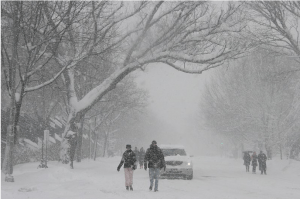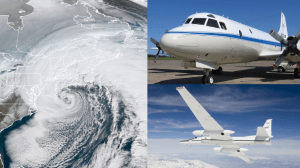March 19, 2020
Lynn McMurdie, on snowstorm research campaign IMPACTS
Have you ever woken up with your whole day planned out, only to realize a giant snowstorm has hit and you are unable to leave your house? Probably not if you live in the Seattle area, but this is a common occurrence on the East Coast. East Coast snowstorms often have a banded structure to them that scientists have yet to fully understand, resulting in poorly predicted snowstorms hitting an unsuspecting population every year.
Working with her colleagues, University of Washington Meteorologist Lynn McMurdie has developed and carried out the Investigation of Microphysics and Precipitation for Atlantic Coast-Threatening Snowstorms (IMPACTS) research project. This project aims to observe the structure of snowbands in East Coast storms, understand the processes that produce these snowbands, and use this knowledge to improve snowfall prediction so those living on the East Coast can better prepare for big storms.
IMPACTS consists of three six-week campaigns taking place throughout January and February 2020-2022, in which researchers will use numerous instruments and a specially equipped P-3 aircraft to better understand the structure of the snowstorms they are studying. Part of the project involves flying directly into the icy, turbulent conditions of winter storms in order to make the necessary observations. “Normally commercial aircraft try to avoid those conditions but we are asking the planes to fly right in the middle of them. Luckily our aircraft . . . is equipped with de-icing equipment and in general can tolerate moderate to even heavy icing conditions,” explains McMurdie, who has experienced being both on the research flights and being behind the scenes directing where the planes will fly.
Organizing a project like this is far from simple. “It takes several years to get a project like this off the ground,” says McMurdie. Not only does it take a couple years to develop a proposal, but once it’s submitted, there is always the possibility the proposal will not be selected for funding. “I got word in October 2018 that we were selected, then we worked tirelessly from
then until January 2020 to get ready for the project. It involves a lot of people – I don’t even know how many, but in the 100’s,” McMurdie continues.
The time and effort will be well worth it though because the knowledge gained from this project will make it possible for major improvements to be made to East Coast snowstorm forecasting, making life easier for millions of people who reside in the region. “It will just need people interested in developing new microphysics schemes based on the data we collect and [implementing] them in our operational forecast models,” McMurdie comments.
Thanks to McMurdie and all of the other researchers on the IMPACTS team, we will soon have a better understanding of the snowstorms that hit the East Coast every winter, and as a result, we will be able to more accurately forecast the snowfall during these storms, allowing those on the East coast to adequately prepare in advance for inclement weather!
If you want to read more on the IMPACTS project, check out the following links:
- https://www.nasa.gov/feature/goddard/2020/nasa-snow-chasers-set-to-fly-into-east-coast-winter-storms
- https://espo.nasa.gov/impacts
- http://impacts.atmos.washington.edu/ImpactsInTheNews.html
You can also follow @SnowIMPACTS on Twitter!
Side note: All images used in this blog post are public domain.
By Rachel Fewkes | The UW Dawgcast


